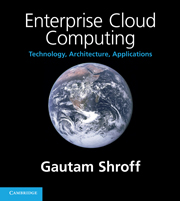Book contents
- Frontmatter
- Contents
- Preface
- List of abbreviations
- Part I Computing platforms
- Part II Cloud platforms
- Part III Cloud technologies
- Part IV Cloud development
- Part V Software architecture
- Chapter 13 Enterprise software: ERP, SCM, CRM
- Chapter 14 Custom enterprise applications and Dev 2.0
- Chapter 15 Workflow and business processes
- Chapter 16 Enterprise analytics and search
- Part VI Enterprise cloud computing
- References
- Index
Chapter 13 - Enterprise software: ERP, SCM, CRM
Published online by Cambridge University Press: 06 December 2010
- Frontmatter
- Contents
- Preface
- List of abbreviations
- Part I Computing platforms
- Part II Cloud platforms
- Part III Cloud technologies
- Part IV Cloud development
- Part V Software architecture
- Chapter 13 Enterprise software: ERP, SCM, CRM
- Chapter 14 Custom enterprise applications and Dev 2.0
- Chapter 15 Workflow and business processes
- Chapter 16 Enterprise analytics and search
- Part VI Enterprise cloud computing
- References
- Index
Summary
So far we have traced the evolution of enterprise architectures from the early mainframes to the emerging paradigms of software as a service and cloud computing, and have examined these primarily from a technical perspective. We now turn our focus to enterprise applications and the functions they perform in the context of a large organization. In particular we study the information maintained in cross-enterprise applications such as enterprise resource planning (ERP), supply chain management (SCM) and customer relationship management (CRM).
ANATOMY OF A LARGE ENTERPRISE
Our first step will be to abstract the anatomy of an large corporation independent of the particular industry it may be a part of. In fact this picture is also applicable for enterprises that may not be corporations, such as governments or educational institutions, and it is only for ease of exposition that we focus on corporations. Further, since the cross-industry abstraction of enterprise software originated as MRP (‘manufacturing requirements planning’), we begin by considering the manufacturing industry.
So, what does a manufacturing corporation do? It plans what products to build, when, and in what quantities. It then executes sales and marketing of its products, coordinates manufacturing across plants and suppliers, and distributes the product to customers and supports them after they have bought the product. These processes are common across discrete manufacturing (easily identifiable products such as computers or cars), as well as process industries (undifferentiated products, such as salt or oil).
- Type
- Chapter
- Information
- Enterprise Cloud ComputingTechnology, Architecture, Applications, pp. 161 - 177Publisher: Cambridge University PressPrint publication year: 2010
- 2
- Cited by

